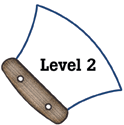
Alaska Science
Key Element A8a
A student who meets the content standard should understand the scientific principles and models that describe the nature of physical, chemical, and nuclear reactions (Energy Transformations).
 |
Alaska Science A student who meets the content standard should understand the scientific principles and models that describe the nature of physical, chemical, and nuclear reactions (Energy Transformations). |
|
Performance Standard Level 2, Ages 8–10
|
|
|
|
Sample Assessment Ideas
|
|
|
Expanded Sample Assessment Idea
|
|
Materials
Suggestions for mix systems:
Procedure Students will:
Reflection and Revision
|
Levels of Performance |
||
|
Stage 4 |
Student response shows clear understanding of evidence regarding chemical reactions vs. physical changes taking place in matter rearrangements. Observations are thorough and interpreted with considerable detail and logical reasoning. | ||
|
Stage 3
|
Student response shows understanding of evidence regarding chemical reactions vs. physical changes taking place in matter rearrangements. Observations are thorough and interpreted with some evidence of logical reasoning. Minor errors may be present. | ||
|
Stage 2
|
Student response shows limited understanding of the difference between physical and chemical changes. Observations are minimal and interpreted with limited evidence of logical reasoning. | ||
|
Stage 1
|
Student response shows little understanding of physical or chemical change. Observations are minimal or totally incorrect, and interpretations show lack of scientific reasoning. | ||
Standards Cross-References
|
||
|
National Science Education Standards Substances react chemically in characteristic ways with other substances to form new substances (compounds) with different characteristic properties. In chemical reactions, the total mass is conserved. Substances often are placed in categories or groups if they react in similar ways; metals is an example of such a group. (Page 154) |
Benchmarks Heating and cooling cause changes in the properties of materials. Many kinds of changes occur faster under hotter conditions. (Page 77) When a new material is made by combining two or more materials, it has properties that are different from the original materials. For that reason, a lot of different materials can be made from a small number of basic kinds of materials. (Page 77) |
|
Table of Contents | Return to Alaska Native Knowledge Network